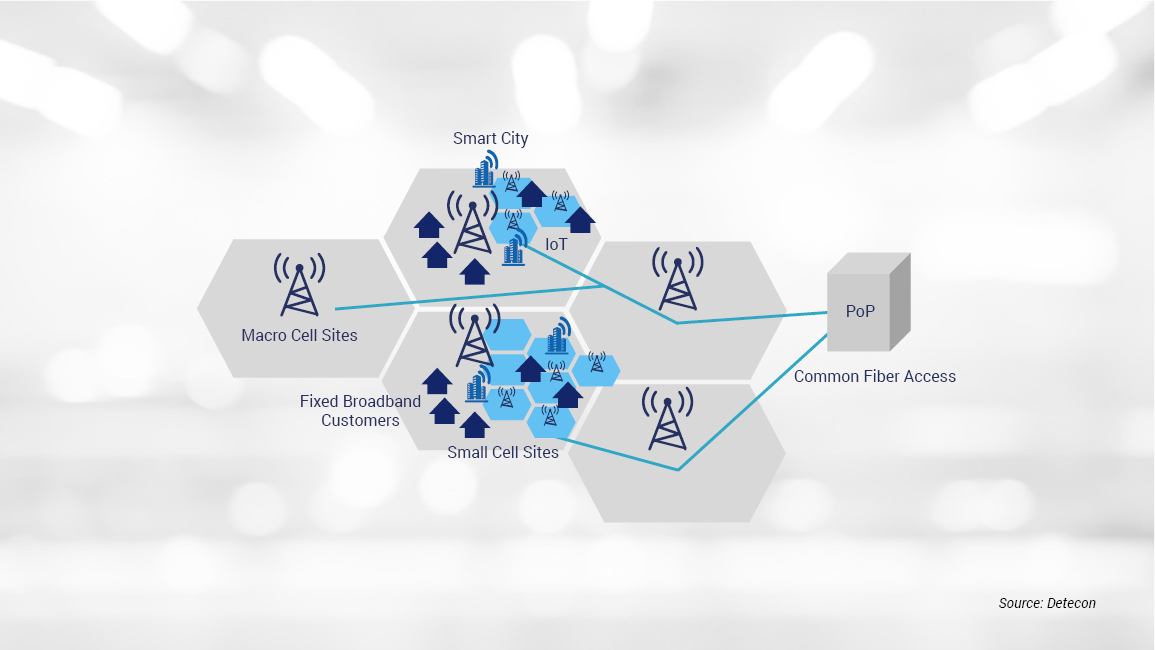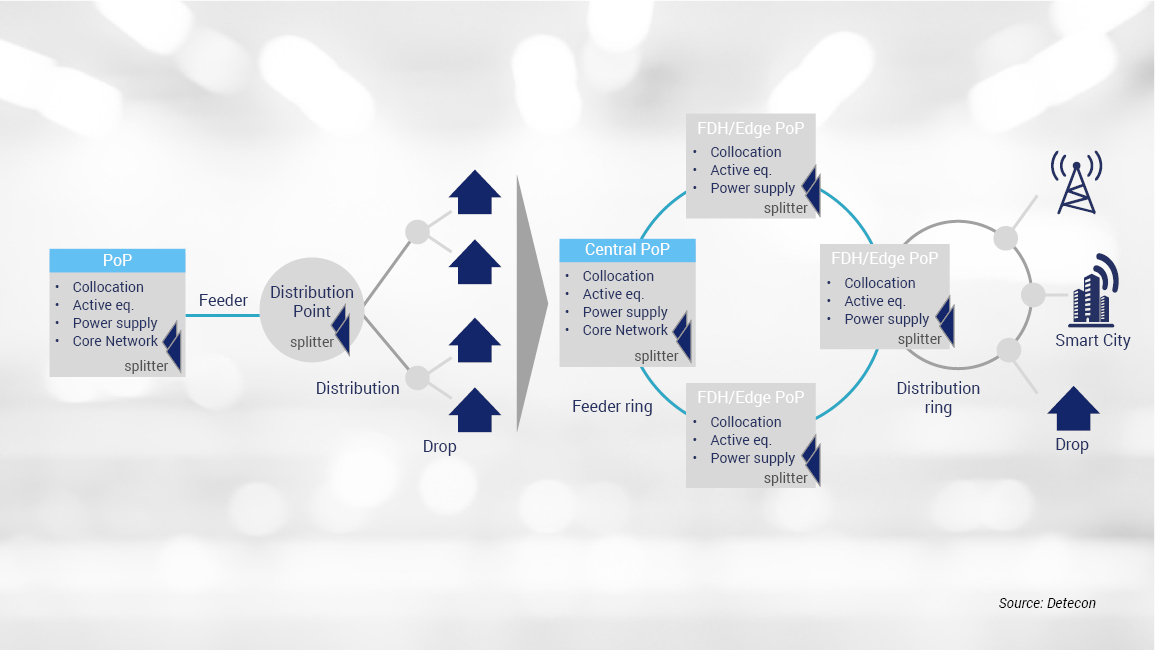For emerging applications, the convergence of fixed and mobile networks in the access domain based on a common fiber optic infrastructure makes sense from both technological and economic viewpoints. But what requirements do future fiber optic networks as key enabler for the digital society need to fulfil?
Connectivity is a key factor and challenge for the digitalization of our cities. The bandwidth demands of end users are growing steadily as the average fixed network internet traffic per broadband line is forecasted to more than double over 2020 (Analysis Mason, “Fixed Network Data Traffic: Worldwide Trends and Forecasts, 2019–2025,” January 2020) by 2025 and mobile data usage per line is expected to follow a similar path (Analysis Mason, “Wireless Network Data Traffic: Worldwide Trends and Forecasts 2020–2025,” July 24, 2020). At the same time, IoT and smart city applications impose additional connectivity requirements that differ from those of traditional fixed and mobile users.
Emerging use cases such as autonomous driving, augmented and virtual reality, or autonomous drones require low latency and heightened reliability of the connections, not only higher bandwidths. Even though these applications are today still mostly in early experimental stages, their deployment is expected to rise in the coming years.
Many of these use cases will rely on the 5G network and its key features: enhanced bandwidth with speeds of 10 Gbit/s and more; ultra-reliable, managed low-latency communications with round trip times of 10 ms and less; and massive connectivity with up to one million connected devices per square kilometer. And while today’s 5G network deployments utilize lower frequency bands and reuse existing macro antenna sites, this is expected to change gradually in the coming years. The increasing connectivity demands and the resulting introduction of higher frequency bands will require a densification of the radio access network, at least in urban areas. The deployment of small cells, and with it the installation of new antenna sites, is expected to rise significantly. The extent of this densification is still to be seen, but the predicted scenarios range from fewer than 20 antenna sites per square kilometer to more than 200 antenna sites per square kilometer. At the same time, implementation of the C-RAN architecture and the resulting shift of functionality of mobile base stations to central sites is driving the increase of bandwidth and latency requirements for connections of remote radio units on antenna sites. These connections rely on the (e)CPRI protocol and primarily on fiber optic as the transmission medium.
Other applications such as video surveillance or Wi-Fi access points do not rely on mobile access for connectivity but are additional demand points with the need for a direct fiber optic connection.

Viewed against the above backdrop, it is evident that a modern fiber optic network infrastructure that will support applications of today and the future is one of the key development factors for today’s cities. The topic of convergence of fixed and mobile networks in the access domain based on a common fiber optic infrastructure has been thematized in the recent past by vendors and industry organizations. To no one’s surprise, the conclusion is that such a convergence makes sense from both technological and economic viewpoints. But what requirements do future fiber optic networks need to fulfil?
The key aspects are the following:
- Increased number of connections: Besides the residential and business fixed customers, antenna sites and various other demand points of current and future smart city/IoT applications will require a fiber optic connection.
- Reliability: While reliability of the connection does not play a significant role for standard residential and business fixed access customers, it will be crucial for critical applications and antenna sites with greater availability requirements.
- Ability to support different connection types: A converged network must be able to serve multiple types of users, applications, and topologies on the same infrastructure. For instance, fixed customers require a P2MP connection while antenna sites require a (redundant) direct connection.
To understand how well today’s network infrastructure is equipped to fulfill the requirements above, we must look at current fixed access network deployments. The technologies and architectures vary significantly around the world.
In many countries of the developed world (e.g., in Western Europe), the deployed networks still rely heavily on legacy copper and coax infrastructure, with vectored VDSL and DOCSIS based on FTTC and HFC architectures dominating the picture. There are various factors driving this development such as the high cost of civil works, and a solid existing copper and coax infrastructure that has been upgraded to offer higher bandwidths to end users. It is clear, however, that these networks are not adequate to serve the approaching demands and will reach their end of life in the near future. They will have to be replaced by full fiber optic networks.
On the other hand, many cities in other parts of the world such as the Middle East, East Asia, and some European countries embraced fiber optic more than a decade ago and have built a network infrastructure based mostly on various flavors of the PON technology and P2MP FTTB/H architecture. These networks have been designed primarily to serve current and future fixed customer demands and are still well equipped for this task. But their ability to accommodate the needs of a converged network is in some cases non-existent and is dependent on their design. Although more capable than copper- and coax-based networks, some existing fiber optic networks will require upgrades as well.
Since the passive network infrastructure is built to last 30 years and more, the concepts and architecture of future fiber optic access networks need to be chosen to fulfill current and future requirements of a converged network. The key design principles of such networks are the following:
- Fiber richness: With the need to connect an increased number of demand points, a higher number of fibers is required. Future fiber optic access networks will need to consider fixed access customer demands as well as demands from mobile antenna sites and various other applications. In addition, as the costs of passive network equipment decrease, the topology of fiber optic networks is expected to move towards P2P from the currently dominant P2MP, at least in the field. Fixed access customers will still be connected to splitters for efficient utilization of the OLTs, but the location of the splitters will likely move from the field to central locations or distribution hubs. Other demand points such as antenna sites will be outfitted with direct fiber optic connections.
- Built-in redundancy: To ensure reliable connections for critical services, the future networks will need to implement redundant routes, at least in parts of the network. One possible way of achieving this is by moving from a star towards a ring topology in the feeder and possibly in the distribution sections of the network.
- Open access: The future converged network needs to provide connectivity for various types of end users and applications. These users and applications will likely not be served by the same service provider or utilize the same network equipment with the consequence that the future network must be built with open interfaces and offer standardized connection services such as dark fiber and BSA. Although this is the case even today for some network deployments, especially when publicly funded, convergence is likely to accelerate this trend.
- Distributed PoP/FDH structure: With an increase in the number of fibers, especially in urban environments, we expect to see a shift from a central PoP that serves greater radius to smaller, more distributed, interconnected central and edge PoPs/fiber distribution hubs (FDH) that terminate a smaller number of end users and offer connectivity, collocation services, and power supply for different providers according to their demands. These sites will be able to host various types of active equipment such as RAN and fixed access nodes, as well as edge computing infrastructure. Such an approach allows for the placement of the right equipment at the right network locations.
The above design principles describe a future-proof, flexible, and resilient fiber optic network infrastructure that inherently supports the diverse applications of a converged network. To what extent and how fast they will be adopted is yet to be seen. However, we can be certain of one thing: fiber optic networks are the key enabler for the digital society.









